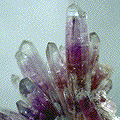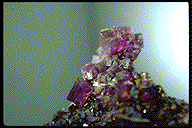MINERAL LOCALITY:
THE MINERAL REGIONS OF GREENLAND
-
The mineral regions of Greenland are unknown to the majority of mineral collectors.
However there are good reasons for collectors to get acquainted with them.
This frigid region has produced nearly three hundred
different mineral species and is the type locality for a number of obscure and exotic minerals.
Many minerals from here are found nowhere else or are the best examples of their species.
Although some of the more important mines are all but played out, there are still some nice specimens to be
found from newly discovered sites or from old collections.
There are four important mineral localities on the world's largest island: Ivigtut, Ilimaussaq, Narssarsuk and Disko Island.
The most well known of all the Greenland localities is Ivigtut on the Arsuk Fjord on the Western side of Greenland's Southern tip. Ivigtut, also spelled Ivittuut, is the type locality to more minerals than any other Greenland locality and indeed has produced more type specimens than most of the mineral localities of the world. It has produced a large number of sulfides, especially sulfosalts and silicates. But it is its pegmatitic halide minerals that are its greatest distinction. Cryolite is by far the most reknown mineral from Greenland and the Ivigtut region. It was mined here starting in the late eighteenth century until the mine closed in the early 1960's. Cryolite was used as a flux in the processing of aluminum. The addition of cryolite in the process cuts the temperature required to obtain aluminum in half. It was considered so strategic during World War II that American troops were stationed here to protect the mines.
The Ilimaussaq Intrusion in the Kangerdluarssuk Fjord is Greenland's most prolific mineral producer in terms of the number of mineral species. It has produced over two hundred different minerals and a number of them are exclusive to this locality. Intrusions rich in alkali metals, especially sodium, and poor in silica and aluminum formed many of the unique assemblages of minerals. These pegmatitic nepheline syenite rocks produced from these unique intrusions are call agpaitic pegmatites after the nearby town of Agpat, Greenland. Agpaitic pegmatites are found scattered around the world. But the agpaitic pegmatites of the Kola Peninsula, Russia;
Langesundfjord , Norway and especially Mont Saint-Hilaire, Quebec, Canada are by far the most famous. The Ilimaussaq Intrusion however is the type locality to many of the more well known agpaitic minerals such as arfvedsonite, eudialyte, eudidymite, polylithionite and sodalite.The Igaliko nepheline syenite intrusion at Narssarsuk, also spelled Narssarsuaq, is the most well known locality next to Ivigtut. This region has been responsible for a variety of new minerals as well. Another nepheline syenite agpaitic intrusion has made Narssarsuk unique, but a later carbonatite intrusion recrystallized much of the rock and produced some even more unique minerals. This site is the type locality for many rare earth minerals, especially the well known rare earth carbonates
ancylite-(Ce) , cordylite-(Ce),rontgenite-(Ce) and synchysite-(Ce).Disko Island is known to zeolite collectors. Located on the Eastern edge of Greenland and stradling the 70th parallel, Disko Island is certainly one of the most Northern of mineral localities. The island is of volcanic origin and within the vesicules of basalt form many varieties of zeolites.
There are many more isolated sites on Greenland that have produced their own unique minerals. Gold and platinum have been found as well as diamond bearing kimberlites. Some localities have produced many unusual native metals such as antimony, bismuth, tin, iron and lead.
Greenland's remoteness, fridgid conditions and environmentally sensitive wilderness areas have limited mineral exploration and exploitation. Specimens from here are currently scarce, but a mineral collector can only hope that there will be more available in the near future. In the table below, most of Greenland's mineral are listed with type specimens shown in bold. Notice the unusual diversity in most of the mineral classes.
The mineral localities of Greenland
have been known to produce specimens of:
-
Acanthite,
allargentum , arsenopyrite, bornite,breithauptite , chalcocite, chalcopyrite,chalcostibite , covellite, cubanite,cuprostibite , digenite,djerfisherite ,djurleite , dyscrasite,famatinite , galena,gudmundite , loellingite,mackinawite , marcasite, molybdenite, nickeline,pearceite , pyrite, pyrrhotite,seinajokite ,skutterudite , sphalerite,stannite ,teallite ,thalcusite ,troilite andwesterveldite .
-
Aikinite ,arcubisite ,chalcothallite ,eskimoite ,gustavite ,matildite , polybasite, pyrargyrite,rohaite ,skinnerite , tetrahedrite,vrbaite ,vikingite andwittichenite .
-
Acuminite ,boggildite ,bogvadite ,chiolite , cryolite,cryolithionite ,elpasolite , fluorite,gearksutite ,jarlite , pachnolite,prosopite ,ralstonite ,stenonite , thomsenolite, villiaumite andweberite .
-
Avicennite , anatase, corundum, cuprite,diaspore ,fersmite ,gerasimovskite , gibbsite, goethite, ice, ilmenite,lepidocrocite ,litharge ,lueshite , magnetite,nordstrandite , perovskite, plattnerite, pyrochlore, pyrolusite,pyrophanite , rutile, senarmontite,thorianite ,todorokite and valentinite.
-
Ancylite-(Ce) , azurite, bastnasite, calcite, cerussite, cordylite-(Ce), dolomite,hydrocerussite ,ikaite , malachite, nahcolite, parisite, rhodochrosite,rontgenite-(Ce) , siderite, smithsonite, synchysite-(Ce),thermonatrite and trona.
- Apatite,
beudantite ,carbonate-hydroxylapatite ,leucophosphite , monazite, rhabdophane andvitusite-(Ce) .
- aegirine,
aenigmatite , albite, allanite-(Ce), analcime,anothoclase , anthophyllite, antigorite, apophyllite, arfvedsonite,ashcroftine-(Y) , astrophyllite, augite,barylite ,beryllite , bertrandite, biotite,britholite-(Ce) , cancrinite, catapleiite, chabazite, chkalovite, chlorite, chrysocolla, clinohumite,cookeite , diopside,eckermannite , elpidite,emeleusite ,ephesite , epididymite, epidote,epistolite , eudialyte, eudidymite, fayalite,gaidonnayite , various garnets,genthelvite , gmelinite,gonnardite ,halloysite ,hastingsite , hedenbergite,helvite , hemimorphite,hiortdahlite ,hisingerite , heulandite,ilimaussite-(Ce) , ilvaite, joaquinite,katophorite ,kentbrooksite , kornerupine,kvanefjeldite , laumontite, leifite, lepidolite, leucophanite,leucosphenite ,levyne ,lomonosovite ,loparite-(Ce) , lorenzenite,lovozerite , mesolite, microcline, montmorillonite, mordenite,mosandrite , murmanite, muscovite,nacareniobsite-(Ce) ,Na-komarovite , narsarsukite, natrolite,naujakasite ,nenadkevichite , nepheline, neptunite,niobophyllite ,nontronite , okenite,offretite , orthoclase, palygorskite, pectolite, phillipsite, phlogopite,plagioclase , polylithionite, prehnite, quartz,reyerite , riebeckite,rinkite ,rosenbuschite ,sauconite , scolecite,semenovite-(Ce) ,sepiolite , serandite, sodalite,sorensenite , sphene,spodiophyllite ,steenstrupine-(Ce) , stilbite,stillwellite , taeniolite,tetranatrolite , thomsonite, thorite, topaz, tremolite,tugtupite ,tundrite-(Ce) ,tundrite-(Nd) ,tuperssuatsiaite ,turkestanite ,ussingite , vesuvianite,vinogradovite ,vishnevite ,vuonnemite , willemite, xonotlite, zinnwaldite and zircon.
bold - indicates that Greenland is the type locality for this mineral.










